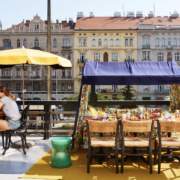The Guardian on Saturday published a list of the “10 coolest neighborhoods in Europe”.
Together with Järntorget/Långgatorna in Goteborg, the University District in Brussels, El Cabanyal in Valencia, and Neukölln in Berlin, the British newspaper mentioned Prague’s Holešovice.
“Holešovice was for a long time seen as a bleak district with little to offer locals, let alone visitors. Its impressive resurgence over the past decade or so has been largely thanks to creative and commercial entrepreneurs taking advantage of low rents and empty spaces – apartment blocks, factories – to create a vibrant infrastructure of galleries, shops, cafes, clubs, and bars. Although not as postcard-pretty as Stare Mesto (the Old Town) or Mala Strana over the river, Holešovice’s blend of industrial buildings, 19th- and early 20th-century tenements (with some lovely art nouveau blocks) and occasional communist behemoths makes for interesting meanders, and there are cultural treats aplenty too,” reports The Guardian.
The most attractive places are the National Technical Museum, Veletržní Palac, which is part of the Prague National Gallery, and a variety of contemporary art spots.
The DOX consistently holds outstanding exhibitions in a former factory complex. Halls 7 and 8 at the Prague Market were transformed into a home for contemporary and experimental art. In addition to the renowned group Cirk La Putyka, you can visit the Trafo Gallery. Not to miss the Chemistry Gallery, La Fabrika and the popular Bio Oko.
History
The first mention of the name Holešovice on record is from 1228. In those days it was a farming village, and the tiny Church of St. Clement – first mentioned in 1234, albeit much older – can still be seen, though it was rebuilt in 1603 due to a fire.
The name Holešovice, originally Holišovice, is evidently derived from the word “holý” or “holec” (“bare”). It could be taken to mean also an infertile part of the land that was often flooded and, after the flooding, there were places full of stones and sand.
The growth of the area was centered around industrialization and the number of factories grew quickly, influencing public transportation infrastructure. By 1884, Holešovice had merged with the ever-growing city of Prague. A massive slaughterhouse and meatpacking facility was built in 1895 that supplied the majority of meat to the city of Prague, and 90 years later, this would turn into Prague’s largest marketplace: Holešovická tržnice.
Support Prague Morning!
We are proud to provide our readers from around the world with independent, and unbiased news for free.
Our dedicated team supports the local community, foreign residents and visitors of all nationalities through our website, social media and newsletter.
We appreciate that not everyone can afford to pay for our services but if you are able to, we ask you to support Prague Morning by making a contribution – no matter how small 🙂 .




